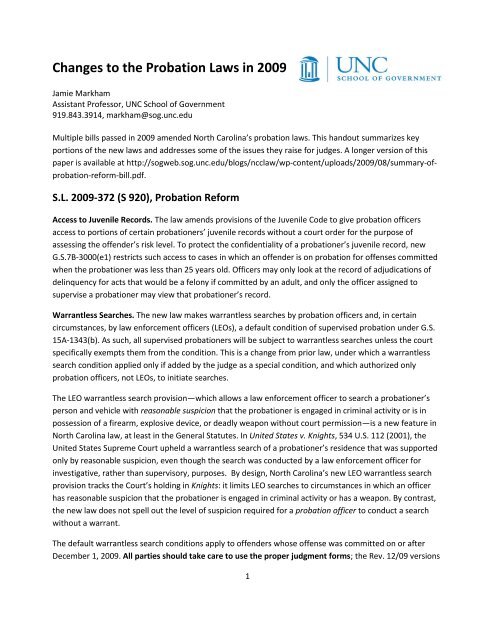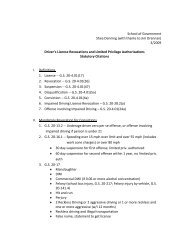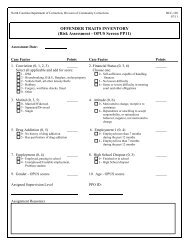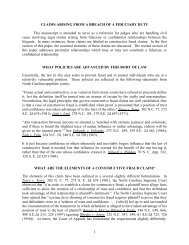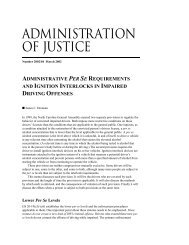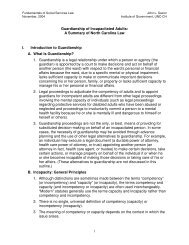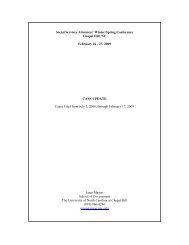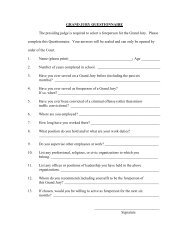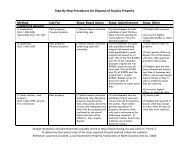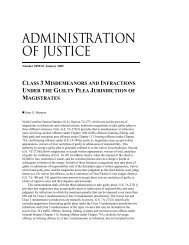Probation Handout - School of Government
Probation Handout - School of Government
Probation Handout - School of Government
You also want an ePaper? Increase the reach of your titles
YUMPU automatically turns print PDFs into web optimized ePapers that Google loves.
Changes to the <strong>Probation</strong> Laws in 2009<br />
Jamie Markham<br />
Assistant Pr<strong>of</strong>essor, UNC <strong>School</strong> <strong>of</strong> <strong>Government</strong><br />
919.843.3914, markham@sog.unc.edu<br />
Multiple bills passed in 2009 amended North Carolina’s probation laws. This handout summarizes key<br />
portions <strong>of</strong> the new laws and addresses some <strong>of</strong> the issues they raise for judges. A longer version <strong>of</strong> this<br />
paper is available at http://sogweb.sog.unc.edu/blogs/ncclaw/wp-content/uploads/2009/08/summary-<strong>of</strong>probation-reform-bill.pdf.<br />
S.L. 2009-372 (S 920), <strong>Probation</strong> Reform<br />
Access to Juvenile Records. The law amends provisions <strong>of</strong> the Juvenile Code to give probation <strong>of</strong>ficers<br />
access to portions <strong>of</strong> certain probationers’ juvenile records without a court order for the purpose <strong>of</strong><br />
assessing the <strong>of</strong>fender’s risk level. To protect the confidentiality <strong>of</strong> a probationer’s juvenile record, new<br />
G.S.7B-3000(e1) restricts such access to cases in which an <strong>of</strong>fender is on probation for <strong>of</strong>fenses committed<br />
when the probationer was less than 25 years old. Officers may only look at the record <strong>of</strong> adjudications <strong>of</strong><br />
delinquency for acts that would be a felony if committed by an adult, and only the <strong>of</strong>ficer assigned to<br />
supervise a probationer may view that probationer’s record.<br />
Warrantless Searches. The new law makes warrantless searches by probation <strong>of</strong>ficers and, in certain<br />
circumstances, by law enforcement <strong>of</strong>ficers (LEOs), a default condition <strong>of</strong> supervised probation under G.S.<br />
15A-1343(b). As such, all supervised probationers will be subject to warrantless searches unless the court<br />
specifically exempts them from the condition. This is a change from prior law, under which a warrantless<br />
search condition applied only if added by the judge as a special condition, and which authorized only<br />
probation <strong>of</strong>ficers, not LEOs, to initiate searches.<br />
The LEO warrantless search provision—which allows a law enforcement <strong>of</strong>ficer to search a probationer’s<br />
person and vehicle with reasonable suspicion that the probationer is engaged in criminal activity or is in<br />
possession <strong>of</strong> a firearm, explosive device, or deadly weapon without court permission—is a new feature in<br />
North Carolina law, at least in the General Statutes. In United States v. Knights, 534 U.S. 112 (2001), the<br />
United States Supreme Court upheld a warrantless search <strong>of</strong> a probationer’s residence that was supported<br />
only by reasonable suspicion, even though the search was conducted by a law enforcement <strong>of</strong>ficer for<br />
investigative, rather than supervisory, purposes. By design, North Carolina’s new LEO warrantless search<br />
provision tracks the Court’s holding in Knights: it limits LEO searches to circumstances in which an <strong>of</strong>ficer<br />
has reasonable suspicion that the probationer is engaged in criminal activity or has a weapon. By contrast,<br />
the new law does not spell out the level <strong>of</strong> suspicion required for a probation <strong>of</strong>ficer to conduct a search<br />
without a warrant.<br />
The default warrantless search conditions apply to <strong>of</strong>fenders whose <strong>of</strong>fense was committed on or after<br />
December 1, 2009. All parties should take care to use the proper judgment forms; the Rev. 12/09 versions<br />
1
include default probation conditions that would not apply to <strong>of</strong>fenders whose crime took place before<br />
December 1, 2009.<br />
Drug/Alcohol Screens as a Warrantless Search? On the old (pre–December 1, 2009) probation judgment<br />
forms, special condition #15 read “Supply a breath, urine and/or blood specimen for analysis <strong>of</strong> the possible<br />
presence <strong>of</strong> a prohibited drug or alcohol, when instructed by the defendant’s probation <strong>of</strong>ficer.” That<br />
condition is not listed on the new form. It may certainly be added in box #20 on the new form, “Other,” as<br />
an ad hoc condition. But does it need to be added? Drug testing is, after all, a kind <strong>of</strong> search. See Schmerber<br />
v. California, 384 U.S. 757 (1966). The new search condition even includes the following language:<br />
“Whenever the warrantless search consists <strong>of</strong> testing for the presence <strong>of</strong> illegal drugs, the probationer may<br />
also be required to reimburse [DOC] for the actual cost <strong>of</strong> drug screening and drug testing, if the results are<br />
positive.” G.S. 15A-1343(b)(13). Thus, the condition clearly contemplates drug tests as one kind <strong>of</strong> search<br />
that may be done without a warrant. It is unclear, though, whether the warrantless search condition allows<br />
an <strong>of</strong>ficer to test for drugs randomly, or whether something like reasonable suspicion might be required for<br />
the condition to kick in. Given this uncertainty, a court that means for a probationer to be subject to<br />
random drug testing might consider saying so explicitly in an ad hoc special condition. (Also note that on<br />
the new judgment forms, the special conditions <strong>of</strong> probation are numbered differently—“13, 14, and 15”<br />
no longer mean what they used to mean.)<br />
Use, Possess, or Control. The new law makes it a default condition for all supervised probationers that they<br />
not use, possess, or control any illegal drug or controlled substance unless it has been prescribed by a<br />
licensed physician; that they not knowingly associate with any known or previously convicted users,<br />
possessors, or sellers <strong>of</strong> such substances; and that they not knowingly be present at or frequent places<br />
where such substances are sold, kept, or used. To the extent that the condition proscribes behavior that is<br />
already criminal (using illegal and unprescribed drugs), it is unobjectionable; courts have generally upheld<br />
similar conditions in other states. E.g., State v. Allen, 634 S.E.2d 653 (S.C. 2006).<br />
Default Conditions for Intermediate Punishment. Under new G.S. 15A-1343(b4), the following conditions<br />
will apply to intermediate probationers unless the judge specifically exempts them:<br />
If required by the <strong>of</strong>ficer, perform community service and pay the community service fee;<br />
Not use, possess, or control alcohol;<br />
Remain within the county <strong>of</strong> residence unless granted permission to leave by the court or the<br />
probation <strong>of</strong>ficer;<br />
Participate in any evaluation, counseling, treatment, or educational program as directed by the<br />
probation <strong>of</strong>ficer.<br />
The prohibition on the use, possession, or control <strong>of</strong> alcohol for all intermediate punishment probationers<br />
may give rise to arguments that the condition is inappropriate for <strong>of</strong>fenders whose crime did not involve<br />
alcohol or substance abuse. Conditions requiring total abstinence have been deemed reasonable in North<br />
Carolina for probationers convicted <strong>of</strong> crimes involving alcohol or drug abuse. See State v. Gallamore, 6 N.C.<br />
2
App. 608 (1969) (impaired driving); State v. Shepherd, 187 N.C. 609 (1924) (violation <strong>of</strong> prohibition laws).<br />
Again, these default intermediate conditions apply only to <strong>of</strong>fenders whose <strong>of</strong>fense is committed on or<br />
after December 1, 2009. All parties should take care to use the proper judgment forms.<br />
Tolling. Under former G.S. 15A-1344(d), a “probation period shall be tolled if the probationer shall have<br />
pending against him criminal charges in any court <strong>of</strong> competent jurisdiction, which, upon conviction, could<br />
result in revocation proceedings against him for violation <strong>of</strong> the terms <strong>of</strong> this probation.” Thus, when a<br />
probationer has a pending charge for any <strong>of</strong>fense other than a Class 3 misdemeanor (under G.S. 15A-<br />
1344(d), probation cannot be revoked solely based on a conviction for a Class 3 misdemeanor), time stops<br />
running on the person’s period <strong>of</strong> probation when the charge is brought, and doesn’t start running until the<br />
charge is resolved by way <strong>of</strong> acquittal, dismissal, or conviction. State v. Henderson, 179 N.C. App. 191<br />
(2006); State v. Patterson, 190 N.C. App. 193 (2008).<br />
The new law, now codified at G.S. 15A-1344(g), explicitly states that a probationer remains subject to the<br />
conditions <strong>of</strong> probation, including supervision fees, during the tolled period. The law also provides that if a<br />
probationer whose case was tolled for a new charge is acquitted or has the charge dismissed, he or she will<br />
receive credit for the time spent under supervision during the tolled period. However, that credit-back<br />
provision only applies to <strong>of</strong>fenses committed on or after December 1, 2009.<br />
Deferred Prosecution. Under G.S. 15A-1341(a1), a court can place certain defendants on probation as a<br />
condition <strong>of</strong> a deferred prosecution agreement with the district attorney. The new law requires in G.S. 15A-<br />
1342(a1) that violations <strong>of</strong> the terms <strong>of</strong> a deferred prosecution agreement be reported to the court as<br />
provided in Article 82 (<strong>Probation</strong>), and not just to the district attorney.<br />
Community Service. The new law removes time limits for completion <strong>of</strong> community service from Chapter<br />
20 concerning impaired driving and Chapter 14 concerning shoplifting, in an effort to give the Division <strong>of</strong><br />
Community Corrections (DCC) and the courts greater flexibility in administering the program. The law also<br />
adds a new subsection to G.S. 20-179.3 to make clear that “significant violations” <strong>of</strong> community service<br />
requirements in impaired driving cases are to be brought before the ordering court for a hearing to<br />
determine if the <strong>of</strong>fender willfully failed to comply, and, if so, that the court must revoke any limited driving<br />
privilege until community service requirements are met.<br />
Other <strong>Probation</strong>-Related Legislation<br />
Transfer low-risk misdemeanants to unsupervised probation (S.L. 2009-275 (S 1089)). Effective July 1,<br />
2009, G.S. 15A-1343(g) was amended to allow a probation <strong>of</strong>ficer to transfer a misdemeanant from<br />
supervised to unsupervised probation if the probationer: (1) is not subject to any special conditions <strong>of</strong><br />
probation; (2) was placed on probation solely for the collection <strong>of</strong> court-ordered payments, and (3) is a low<br />
risk according to a Division <strong>of</strong> Community Corrections risk assessment. This transfer, which does not relieve<br />
the probationer <strong>of</strong> the obligation to make court-ordered payments, may be done without court<br />
authorization.<br />
3
New pretrial release requirements for certain probationers (S.L. 2009-412 (S 1078), further amended by<br />
S.L. 2009-547 (S 726)). This law adds new G.S. 15A-534(d2) to provide that when a judicial <strong>of</strong>ficial is<br />
considering pretrial release conditions for a defendant who is charged with a felony and is currently on<br />
probation, the <strong>of</strong>ficial must determine and make a written record <strong>of</strong> whether the defendant poses a danger<br />
to the public. If the <strong>of</strong>ficial determines that the defendant poses a danger, the <strong>of</strong>ficial must impose a<br />
secured bond under subdivision (a)(4) or electronic house arrest with a secured bond under subdivision<br />
(a)(5) . If there is insufficient information to determine whether the defendant poses a danger to the public,<br />
the defendant must be retained in custody under a written order until a determination is made.<br />
The law also amends G.S. 15A-1345 to require a similar determination <strong>of</strong> dangerousness when a<br />
probationer is arrested for a violation <strong>of</strong> probation and also has a felony charge pending (or, under a law<br />
passed last year, has ever been convicted <strong>of</strong> a crime that now requires sex <strong>of</strong>fender registration). Prior to<br />
imposing release conditions for such probationers, a judicial <strong>of</strong>ficial must make a written determination <strong>of</strong><br />
whether the probationer poses a danger to the public. If the probationer is found not to pose a danger, he<br />
or she may be released as otherwise provided in Article 26 <strong>of</strong> Chapter 15A. If the probationer is found to<br />
pose a danger to the public, he or she must be denied release pending a revocation hearing. Though the<br />
law purports to require that dangerous probationers be held without release until a final violation hearing<br />
is held, probationers are still entitled under G.S. 15A-1345(c) (and as a matter <strong>of</strong> constitutional due process<br />
under Morrissey v. Brewer, 408 U.S. 471, 485 (1972), and Gagnon v. Scarpelli, 411 U.S. 778 (1973)) to a<br />
preliminary probation violation hearing within seven working days. If the judicial <strong>of</strong>ficial determines that he<br />
or she has insufficient information to determine whether the defendant poses a danger, the <strong>of</strong>ficial must<br />
retain the defendant in custody for not more than seven days from the date <strong>of</strong> arrest to obtain sufficient<br />
information to make a determination. If, after seven days, sufficient information is still unavailable, the<br />
defendant must be brought before a judicial <strong>of</strong>ficial, who shall record the lack <strong>of</strong> information in writing and<br />
impose conditions <strong>of</strong> release.<br />
Tampering with EHA equipment (S.L. 2009-415 (S 713)). This law makes it a crime for a person subject to<br />
monitoring by an electronic device as a condition <strong>of</strong> house arrest, bond, pretrial release, probation, parole,<br />
or post-release supervision to remove, destroy, or circumvent the operation <strong>of</strong> the device. The <strong>of</strong>fense class<br />
<strong>of</strong> the new tampering crime varies depending on the seriousness <strong>of</strong> the <strong>of</strong>fense for which the person is<br />
under supervision.<br />
EHA leave (S.L. 2009-547 (S 726)). Effective for <strong>of</strong>fenses committed on or after December 1, 2009, this law<br />
amends G.S. 15A-1340.11(4a) (the definition <strong>of</strong> house arrest with electronic monitoring) and 15A-<br />
1343(b1)(3c) (the special probation condition requiring a probationer to remain at his or her residence) to<br />
provide that a probation <strong>of</strong>ficer may authorize a probationer to leave his or her residence for specific<br />
purposes not authorized by the court with the approval <strong>of</strong> the probation <strong>of</strong>ficer’s supervisor.<br />
4
COMMON SENTENCING ERRORS<br />
Consider whether the court committed error in each <strong>of</strong> the scenarios below<br />
1. A defendant is convicted <strong>of</strong> a misdemeanor. He is sentenced to community punishment—24 months <strong>of</strong><br />
supervised probation. The trial court makes no findings related to length <strong>of</strong> the period <strong>of</strong> probation.<br />
2. At a probationer’s violation hearing, two sentences that had been set to run concurrently by the<br />
original sentencing judge are run consecutively by the revoking judge.<br />
3. A defendant pleads guilty to a felony. At sentencing, the court counts prior record points for a felony<br />
habitual DWI and the three misdemeanor DWIs that led to the habitual DWI conviction.<br />
4. A probationer spends 90 days at DART-Cherry as a condition <strong>of</strong> probation. He later violates probation<br />
and has his probation revoked. He asks for credit against the suspended sentence for the time spent at<br />
DART-Cherry. The judge denies the request.<br />
5. A defendant spends 211 days on electronic house arrest as a condition <strong>of</strong> pretrial release. After<br />
conviction, she petitions the court for credit against her sentence for this time. The judge denies the<br />
petition.<br />
6. A defendant’s probation is revoked. A few months earlier she had been held in contempt <strong>of</strong> court under<br />
G.S. 15A-1344(e1) for a violation <strong>of</strong> probation and jailed for 30 days. She asks for credit against her<br />
suspended sentence for the time spent in jail for the contempt. The judge grants the request.<br />
7. A Level III defendant is convicted <strong>of</strong> a Class 1 misdemeanor [1–120 days, C/I/A]. The judge sentences<br />
him to 100 days, suspended, with 40 days <strong>of</strong> special probation confinement (a 40 day split) as an<br />
intermediate condition <strong>of</strong> probation.<br />
8. A defendant is convicted <strong>of</strong> a Level Two DWI [7 days minimum, 12 months maximum]. The judge<br />
sentences her to 8 months, suspended, with 3 months <strong>of</strong> special probation confinement (a 3 month<br />
split) as a condition <strong>of</strong> probation.<br />
9. A defendant pleads guilty to sexual battery for an <strong>of</strong>fense against his 12-year-old stepdaughter, who<br />
lives with the defendant and his wife. He is sentenced to probation. The judge does not add the special<br />
sex <strong>of</strong>fender conditions set out in G.S. 15A-1343(b2) [and included on Page 2, Side 2 <strong>of</strong> Form AOC-CR-<br />
603], including the condition that the defendant not reside in a household with any minor child.<br />
10. A defendant is charged with sexual battery for an <strong>of</strong>fense against his 12-year-old stepdaughter. To<br />
avoid having to register as a sex <strong>of</strong>fender, he pleads guilty to assault on a female. The judge does not<br />
add the special conditions <strong>of</strong> probation set out in G.S. 15A-1343(b2), including the condition that the<br />
defendant not reside in a household with any minor child.
11. A Level I defendant is convicted <strong>of</strong> a Class 1 misdemeanor [1–45 days, C]. The judge sentences the<br />
defendant to 45 days, suspended, with a special condition requiring the defendant to submit to house<br />
arrest with electronic monitoring for the first 3 months <strong>of</strong> a 12 month probationary period.<br />
12. A Level I defendant is convicted <strong>of</strong> a Class 1 misdemeanor [1–45 days, C], and sentenced to probation.<br />
He violates probation. At his violation hearing, the judge modifies his probation to add special<br />
probation, requiring the defendant to serve 5 days in the jail.<br />
13. A defendant is convicted <strong>of</strong> injury to real property. The judge continues prayer for judgment for 12<br />
months on the condition that the defendant pay for the damage. A year later the defendant <strong>of</strong>fers<br />
pro<strong>of</strong> that he paid the money and asks the court to dismiss the charge, which the court does.<br />
14. A Level II defendant is convicted <strong>of</strong> six counts <strong>of</strong> a Class 1 misdemeanor [1–45 days, C/I/A]. The judge,<br />
seeking the longest permissible sentence, imposes consecutive active terms totaling 240 days.<br />
15. A defendant is convicted <strong>of</strong> assault on a female for an <strong>of</strong>fense against his ex-wife. He is sentenced to<br />
probation and ordered to pay $500 in restitution for the victim’s medical bills. His probation is later<br />
revoked. At the revocation hearing, the court makes a finding that the money is still owed and orders<br />
that it be entered as a civil judgment against the defendant.<br />
16. A defendant’s probation is revoked in district court. He appeals to superior court for a de novo hearing,<br />
and the superior court decides to continue him on probation under modified conditions. Later, he<br />
violates probation again. The district court revokes his probation.<br />
17. A defendant is convicted <strong>of</strong> injury to real property. The judge sentences him to probation, with<br />
restitution in an amount and payment schedule to be determined by the probation <strong>of</strong>ficer.<br />
18. In 2006, a defendant is sentenced to a 3-year term <strong>of</strong> probation. Late in the third year a violation report<br />
is filed (and file-stamped), but the violation hearing doesn’t take place until several months after the<br />
period <strong>of</strong> probation expires. The defendant moves to dismiss, arguing that the court lacks jurisdiction to<br />
hold the hearing because the State failed to demonstrate a reasonable effort to conduct the hearing<br />
earlier. The court revokes her probation.<br />
19. A defendant pleads guilty to a felony. As part <strong>of</strong> a plea agreement, he stipulates to the information on a<br />
prior record level worksheet, including a Virginia conviction for armed robbery. The defendant further<br />
stipulates that the Virginia conviction is “substantially similar” to armed robbery in North Carolina, and<br />
thus should count as a Class D felony (6 points) for prior record level purposes instead <strong>of</strong> a Class I felony<br />
(2 points, the default for out-<strong>of</strong>-state felony convictions).<br />
20. A defendant is sentenced to a 3-year term <strong>of</strong> probation with a large amount <strong>of</strong> restitution owed. It<br />
becomes clear in the second year <strong>of</strong> probation that he will not be able to pay the restitution by the end<br />
<strong>of</strong> the original probation term, so he consents to an extension to five years. After 4 years and 9 months,<br />
he still has restitution left to pay. He consents to an additional extension <strong>of</strong> three years to complete the<br />
restitution. The court extends his probation to 8 years.


